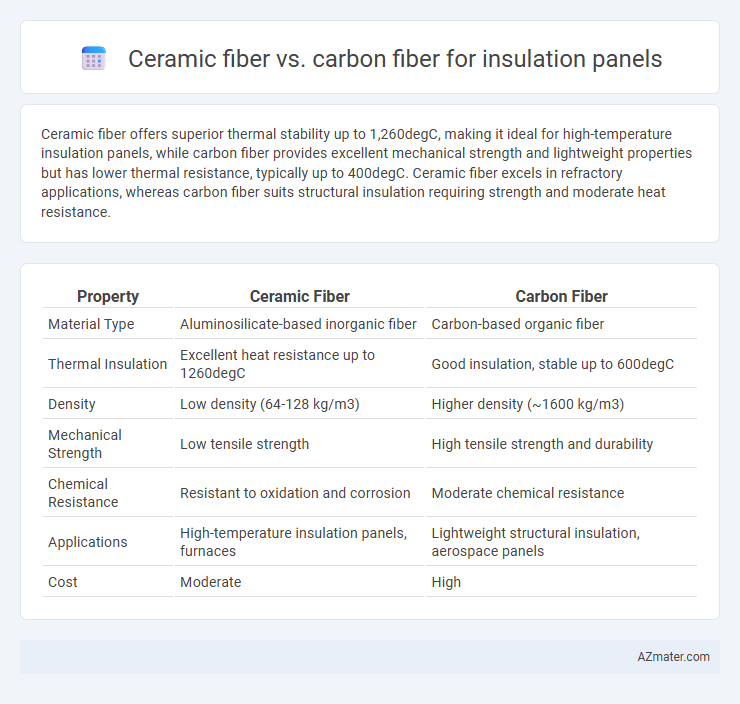Ceramic fiber offers superior thermal stability up to 1,260degC, making it ideal for high-temperature insulation panels, while carbon fiber provides excellent mechanical strength and lightweight properties but has lower thermal resistance, typically up to 400degC. Ceramic fiber excels in refractory applications, whereas carbon fiber suits structural insulation requiring strength and moderate heat resistance.
Table of Comparison
| Property | Ceramic Fiber | Carbon Fiber |
|---|---|---|
| Material Type | Aluminosilicate-based inorganic fiber | Carbon-based organic fiber |
| Thermal Insulation | Excellent heat resistance up to 1260degC | Good insulation, stable up to 600degC |
| Density | Low density (64-128 kg/m3) | Higher density (~1600 kg/m3) |
| Mechanical Strength | Low tensile strength | High tensile strength and durability |
| Chemical Resistance | Resistant to oxidation and corrosion | Moderate chemical resistance |
| Applications | High-temperature insulation panels, furnaces | Lightweight structural insulation, aerospace panels |
| Cost | Moderate | High |
Introduction: Comparing Ceramic Fiber and Carbon Fiber for Insulation Panels
Ceramic fiber offers excellent thermal resistance up to 2300degF (1260degC) and superior chemical stability, making it ideal for high-temperature insulation panels in industrial furnaces. Carbon fiber provides exceptional mechanical strength and low thermal conductivity, suitable for lightweight insulation panels requiring structural integrity and heat resistance up to 500degC. Choosing between ceramic and carbon fiber depends on specific applications, temperature requirements, and performance criteria for insulation panels.
Material Composition and Structure
Ceramic fiber insulation panels consist primarily of alumina and silica, forming a amorphous structure with high thermal stability and low thermal conductivity, ideal for high-temperature environments. Carbon fiber panels are made from carbon atoms arranged in a crystalline lattice, providing exceptional tensile strength, electrical conductivity, and moderate thermal insulation capabilities. The porous, fibrous structure of ceramic fibers enhances heat resistance, while the dense, aligned carbon fibers offer superior mechanical strength but lower heat resistance compared to ceramic counterparts.
Thermal Insulation Performance
Ceramic fiber insulation panels exhibit superior thermal resistance, withstanding temperatures up to 2300degF (1260degC) while maintaining low thermal conductivity around 0.23 W/m*K, ideal for high-temperature industrial applications. Carbon fiber panels offer excellent thermal conductivity control and strength but typically operate effectively below 1000degF (538degC), limiting their use in extreme heat environments. The choice between ceramic fiber and carbon fiber panels fundamentally depends on the specific temperature range and insulation efficiency required for the application.
Heat Resistance and Temperature Limits
Ceramic fiber insulation panels exhibit exceptional heat resistance, withstanding continuous temperatures up to 2300degF (1260degC), making them ideal for high-temperature industrial applications. Carbon fiber insulation panels offer good thermal stability but typically tolerate lower maximum temperatures around 1200degF (650degC), limiting their use in extreme heat environments. The superior temperature limit of ceramic fibers provides enhanced insulation performance in furnaces, kilns, and heat treatment processes, whereas carbon fibers are better suited for moderate heat insulation with added structural strength.
Mechanical Strength and Durability
Ceramic fiber insulation panels exhibit exceptional high-temperature resistance and excellent thermal stability, making them ideal for harsh industrial environments, but their mechanical strength is lower compared to carbon fiber. Carbon fiber insulation panels offer superior tensile strength, enhanced impact resistance, and greater durability under mechanical stress, ensuring long-term structural integrity. Selection depends on application specifics, where ceramic fibers excel in thermal insulation and carbon fibers provide robust mechanical performance.
Weight and Density Comparison
Ceramic fiber insulation panels typically have a density ranging from 96 to 320 kg/m3, making them lightweight with excellent thermal resistance at high temperatures up to 1260degC. Carbon fiber insulation panels, while denser at approximately 1500 to 2000 kg/m3, offer superior mechanical strength and thermal conductivity control but are heavier compared to ceramic fiber options. The lower density of ceramic fiber panels makes them preferable for applications requiring minimal weight and efficient high-temperature insulation.
Fire Safety and Flame Resistance
Ceramic fiber insulation panels offer superior fire safety with excellent resistance to temperatures above 2300degF (1260degC), making them ideal for high-heat industrial environments. Carbon fiber insulation panels provide good flame resistance but typically withstand lower maximum temperatures around 1200degF (650degC), limiting their use in extreme fire conditions. The non-combustible nature and low thermal conductivity of ceramic fibers ensure enhanced flame resistance and structural integrity during fire exposure compared to carbon fiber alternatives.
Cost and Economic Considerations
Ceramic fiber insulation panels generally offer lower upfront costs compared to carbon fiber panels, making them more economically viable for large-scale industrial applications requiring high-temperature resistance. Carbon fiber panels, while significantly more expensive due to raw material and manufacturing complexities, provide superior strength-to-weight ratios and enhanced durability, potentially reducing replacement frequency and long-term maintenance costs. Evaluating total lifecycle expenses, including installation, energy efficiency, and durability, is crucial when determining the most cost-effective insulation solution for specific project requirements.
Environmental Impact and Sustainability
Ceramic fiber insulation panels exhibit lower environmental impact due to their higher durability and recyclability compared to carbon fiber, which often involves energy-intensive production with significant carbon emissions. The raw materials for ceramic fibers are abundant and non-toxic, contributing to better sustainability profiles, whereas carbon fiber production relies heavily on petroleum-based resources and generates hazardous waste. Lifecycle analyses highlight ceramic fiber's advantage in reducing ecological footprint while maintaining high thermal resistance for industrial insulation applications.
Best Applications for Ceramic vs Carbon Fiber Insulation Panels
Ceramic fiber insulation panels excel in high-temperature environments such as furnaces, kilns, and industrial ovens due to their exceptional thermal stability and resistance to thermal shock. Carbon fiber insulation panels are better suited for applications requiring lightweight and high mechanical strength, including aerospace and automotive components where thermal insulation combined with structural support is critical. While ceramic fibers provide superior heat resistance up to 1800degC, carbon fibers offer enhanced electrical conductivity and tensile strength, making each ideal for specific industrial insulation needs.

Infographic: Ceramic fiber vs Carbon fiber for Insulation panel
 azmater.com
azmater.com